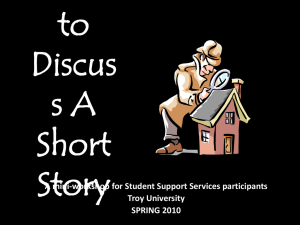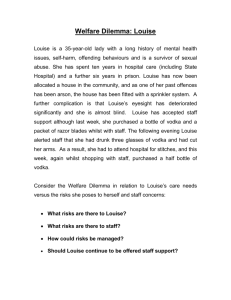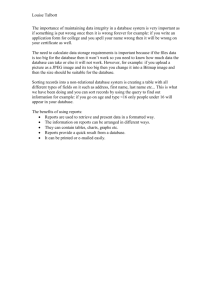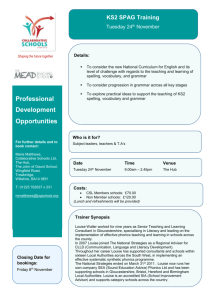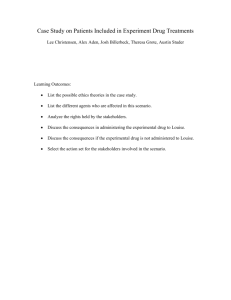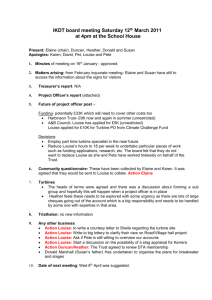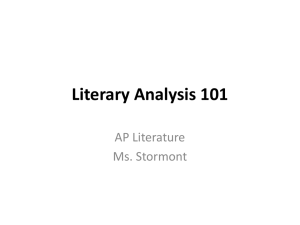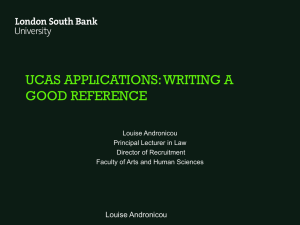The Story Of An Hour-Literary Elements and Techniques
advertisement
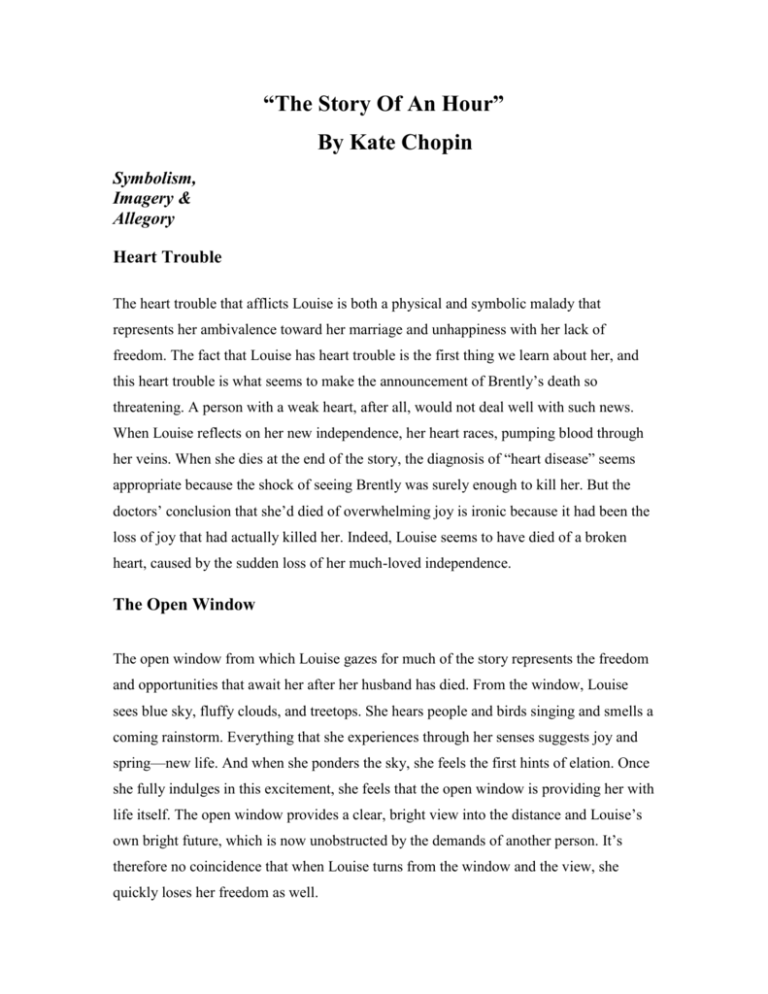
“The Story Of An Hour” By Kate Chopin Symbolism, Imagery & Allegory Heart Trouble The heart trouble that afflicts Louise is both a physical and symbolic malady that represents her ambivalence toward her marriage and unhappiness with her lack of freedom. The fact that Louise has heart trouble is the first thing we learn about her, and this heart trouble is what seems to make the announcement of Brently’s death so threatening. A person with a weak heart, after all, would not deal well with such news. When Louise reflects on her new independence, her heart races, pumping blood through her veins. When she dies at the end of the story, the diagnosis of “heart disease” seems appropriate because the shock of seeing Brently was surely enough to kill her. But the doctors’ conclusion that she’d died of overwhelming joy is ironic because it had been the loss of joy that had actually killed her. Indeed, Louise seems to have died of a broken heart, caused by the sudden loss of her much-loved independence. The Open Window The open window from which Louise gazes for much of the story represents the freedom and opportunities that await her after her husband has died. From the window, Louise sees blue sky, fluffy clouds, and treetops. She hears people and birds singing and smells a coming rainstorm. Everything that she experiences through her senses suggests joy and spring—new life. And when she ponders the sky, she feels the first hints of elation. Once she fully indulges in this excitement, she feels that the open window is providing her with life itself. The open window provides a clear, bright view into the distance and Louise’s own bright future, which is now unobstructed by the demands of another person. It’s therefore no coincidence that when Louise turns from the window and the view, she quickly loses her freedom as well. Motif: Weeping Louise’s weeping about Brently’s death highlight the dichotomy between sorrow and happiness. Louise cries or thinks about crying for about three-quarters of “The Story of an Hour,” stopping only when she thinks of her new freedom. Crying is part of her life with Brently, but it will presumably be absent from her life as an independent woman. At the beginning of the story, Louise sobs dramatically when she learns that Brently is dead, enduring a “storm of grief.” She continues weeping when she is alone in her room, although the crying now is unconscious, more a physical reflex than anything spurred by emotion. She imagines herself crying over Brently’s dead body. Once the funeral is over in her fantasies, however, there is no further mention of crying because she’s consumed with happiness. Setting: An isolated "community" sometime in the future Yes, our description rather vague, but so is the setting in The Giver. We can't be sure when the story goes down, but since the memories of a distant past correspond to OUR world today, we conclude that it is, in fact, some time in the future. Lowry has created in The Giver an entire world, unique from what we know but with certain similarities. There's enough to make it familiar to us, but elements that make us uncomfortable, too. For instance, Jonas has sexual urges just like we do (normal), but he has to take a pill to make his go away (weird). He has a family, with parents and a little sister (normal), but they're all selected by a committee to form a family unit (weird). This strange dichotomy is what makes The Giver so enticing. Point Of View: Third Person (Limited) The story is told from a detached, third-person limited point of view. The reader identifies with Louise, the only character whose thoughts are accessible. Tone: Intense, Powerful, Ironic In “The Story of an Hour,” Chopin employs specific structural and stylistic techniques to heighten the drama of the hour. The structure Chopin has chosen for “The Story of an Hour” fits the subject matter perfectly. The story is short, made up of a series of short paragraphs, many of which consist of just two or three sentences. Likewise, the story covers only one hour in Louise Mallard’s life—from the moment she learns of her husband’s death to the moment he unexpectedly returns alive. The short, dense structure mirrors the intense hour Louise spends contemplating her new independence. Just as Louise is completely immersed in her wild thoughts of the moment, we are immersed along with her in this brief period of time. This story can be read quickly, but the impact it makes is powerful. Irony: Chopin surprises us first with Louise’s elated reaction when she first murmurs “free” to herself. She shocks us again at the conclusion when she dies upon Brently’s return. The “heart disease” mentioned at the end of the story echoes the “heart trouble” discussed at the beginning, intensifying the twist ending and bringing the story to a satisfying close. Themes: *Themes are the fundamental and often universal ideas explored in a literary work. 1) Theme of The Forbidden Joy of Independence In “The Story of an Hour,” independence is a forbidden pleasure that can be imagined only privately. When Louise hears from Josephine and Richards of Brently’s death, she reacts with obvious grief, and although her reaction is perhaps more violent than other women’s, it is an appropriate one. Alone, however, Louise begins to realize that she is now an independent woman, a realization that enlivens and excites her. Even though these are her private thoughts, she at first tries to squelch the joy she feels, to “beat it back with her will.” Such resistance reveals how forbidden this pleasure really is. When she finally does acknowledge the joy, she feels possessed by it and must abandon herself to it as the word free escapes her lips. Louise’s life offers no refuge for this kind of joy, and the rest of society will never accept it or understand it. Extreme circumstances have given Louise a taste of this forbidden fruit, and her thoughts are, in turn, extreme. She sees her life as being absolutely hers and her new independence as the core of her being. Overwhelmed, Louise even turns to prayer, hoping for a long life in which to enjoy this feeling. When Brently returns, he unwittingly yanks Louise’s independence away from her, putting it once again out of her reach. The forbidden joy disappears as quickly as it came, but the taste of it is enough to kill her. 2) Theme of Oppressiveness of Marriage Chopin suggests that all marriages, even the kindest ones, are inherently oppressive. Louise, who readily admits that her husband was kind and loving, nonetheless feels joy when she believes that he has died. Her reaction doesn’t suggest any malice, and Louise knows that she’ll cry at Brently’s funeral. However, despite the love between husband and wife, Louise views Brently’s death as a release from oppression. She never names a specific way in which Brently oppressed her, hinting instead that marriage in general stifles both women and men. She even seems to suggest that she oppressed Brently just as much as he oppressed her. Louise’s epiphany in which these thoughts parade through her mind reveals the inherent oppressiveness of all marriages, which by their nature rob people of their independence. Major Characters: Louise Mallard - A woman whose husband is reportedly killed in a train accident. When Louise hears the news, she is secretly happy because she is now free. She is filled with a new lust for life, and although she usually loved her husband, she cherishes her newfound independence even more. She has a heart attack when her husband, alive after all, comes home. An intelligent, independent woman, Louise Mallard understands the “right” way for women to behave, but her internal thoughts and feelings are anything but correct. When her sister announces that Brently has died, Louise cries dramatically rather than feeling numb, as she knows many other women would. Her violent reaction immediately shows that she is an emotional, demonstrative woman. She knows that she should grieve for Brently and fear for her own future, but instead she feels elation at her newfound independence. Louise is not cruel and knows that she’ll cry over Brently’s dead body when the time comes. But when she is out of others’ sight, her private thoughts are of her own life and the opportunities that await her, which she feels have just brightened considerably. Louise suffers from a heart problem, which indicates the extent to which she feels that marriage has oppressed her. The vague label Chopin gives to Louise’s problem—“heart trouble”—suggests that this trouble is both physical and emotional, a problem both within her body and with her relationship to Brently. In the hour during which Louise believes Brently is dead, her heart beats strongly—indeed, Louise feels her new independence physically. Alone in her room, her heart races, and her whole body feels warm. She spreads her arms open, symbolically welcoming her new life. “Body and soul free!” she repeats to herself, a statement that shows how total her new independence really is for her. Only when Brently walks in does her “heart trouble” reappear, and this trouble is so acute that it kills her. The irony of the ending is that Louise doesn’t die of joy as the doctors claim but actually from the loss of joy. Brently’s death gave her a glimpse of a new life, and when that new life is swiftly taken away, the shock and disappointment kill her. Brently Mallard - Louise’s husband, supposedly killed in a train accident. Although Louise remembers Brently as a kind and loving man, merely being married to him also made him an oppressive factor in her life. Brently arrives home unaware that there had been a train accident. Josephine - Louise’s sister. Josephine informs Louise about Brently’s death. Richards - Brently’s friend. Richards learns about the train accident and Brently’s death at the newspaper office, and he is there when Josephine tells the news to Louise.
